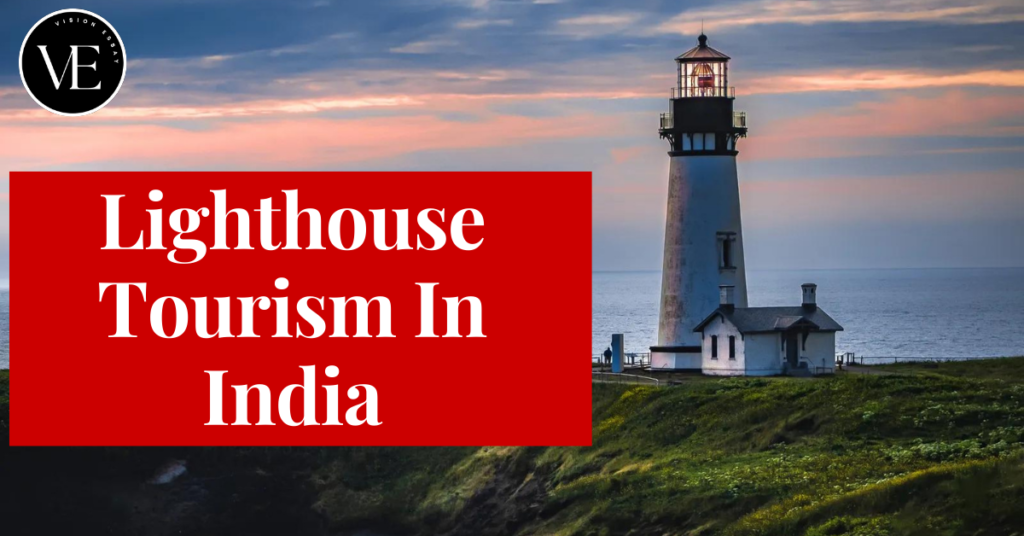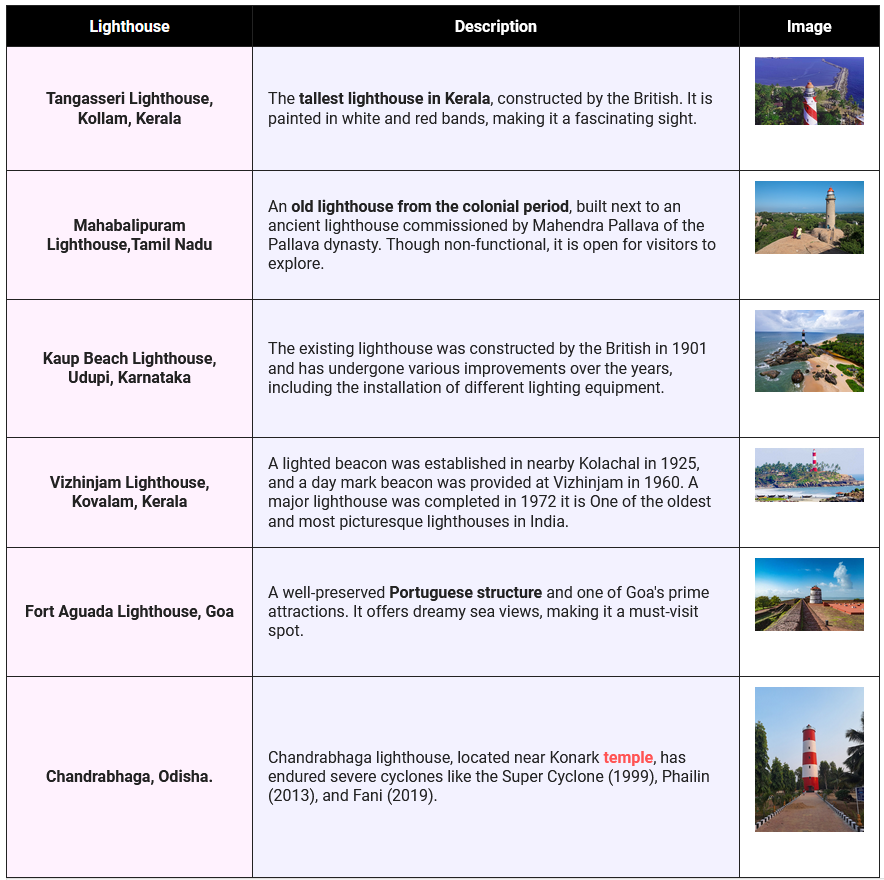Lighthouse Tourism in India

Introduction
During a stakeholders conference hosted by the Directorate General of Lighthouses and Lightships in Vizhinjam, Kerala, the Union Minister of Ports, Shipping & Waterways revealed intentions to promote lighthouse tourism under the Maritime India Vision (MIV) 2030 and Maritime Amrit Kaal Vision 2047 in India.
What is Lighthouse Tourism?
Lighthouse tourism refers to visiting and exploring lighthouses as tourist attractions. Lighthouses, historically used as navigational aids for ships at sea, have become popular destinations for tourists due to their scenic locations, architectural significance, and historical importance. People often visit lighthouses to learn about their history, enjoy panoramic views from their towers, and appreciate their cultural and maritime heritage. Many lighthouses worldwide have been preserved and restored specifically to attract tourists, offering guided tours, museums, and sometimes even accommodations for overnight stays.
What is Lighthouse?
A lighthouse is any tower, building, or other structure used to help local fishermen and seafarers navigate by emitting light using a system of lights and lenses. Lighthouses indicate safe harbor entrances, hazardous reefs, and coasts.
What is the Historical Role of Lighthouse?
- Ancient India: The Purva (East) and Paschima (West) Samudras of the Rigveda and Satapatha Brahmana make navigation reference. Varuna and Vashistha’s maritime travels are also described in the Rigveda.
- Significant Modern Marvels

What is the Role of Modern Lighthouses in India?
- Lighthouses of today still direct ships, indicate ports, and transmit messages; they are an invaluable complement to GPS systems.
- Modern radars were installed on lighthouses to monitor the coast following the 2008 Mumbai terror attacks.
- The Indian government developed the Automatic Identification System (AIS) to help lighthouses and fishermen communicate.
- The goal of the Marine Aids to Navigation Act of 2021 was to raise awareness of lighthouses’ cultural and historical significance.
- Occasions like the Indian Lighthouse Festival in Goa highlight these buildings’ historical significance and tourist potential. Nowadays, many lighthouses are tourist destinations, providing breathtaking vistas and historical insights.
What are the Benefits of Increasing Lighthouse Tourism in India?
- Cultural Heritage: Events like India’s First Lighthouse Festival, “the Bharatiya Prakash Sthamb Utsav,” held at the historic Fort Aguada in Goa, celebrate India’s rich maritime heritage and raise awareness and appreciation of historical lighthouses that have been largely ignored. Lighthouses are educational hubs because they offer historical and cultural value.
- Economic Development: 75 lighthouses have been recognized by the Directorate General of Lighthouses and Lightships for possible investment in tourism development, offering financial advantages to the neighboring communities.
- Environmental Awareness: Heritage lighthouses serve as a focal point for eco-friendly tourism strategies that both preserve and attract tourists to coastal areas.
What is the Impact of Lighthouse Tourism on Local Communities?
- Economic Benefits: Local communities reap substantial economic benefits from lighthouse tourism. Through tourism-related activities, it brings in money, supports regional companies, and create employment.
- Preservation and Conservation Efforts: Better lighthouse conservation and preservation initiatives may result in more tourists. To guarantee that these historic buildings are maintained for the next generations, the money raised might be allocated toward upkeep and restoration efforts.
- Cultural Exchange: Tourists and local communities may exchange cultures thanks to lighthouse tourism. Discovering the habits, traditions, and way of life of the locals helps visitors appreciate and comprehend other cultures on a deeper level.
What are the Challenges in Promoting Lighthouse Tourism?
- Accessibility Issues: The fact that many lighthouses are situated in isolated or difficult-to-reach places makes accessibility difficult. Enhancing infrastructure and transportation is crucial to increasing visitor accessibility to these locations.
- Maintenance and Safety Concerns: To keep lighthouses safe for tourists, they need to be maintained regularly. Their maintenance may be difficult due to a lack of funding and resources.
- Environmental Impact: Particularly in coastal regions, tourism may hurt the ecosystem. To reduce this impact and save the surrounding environment, it is critical to adopt sustainable tourist practices.
What is the Maritime India Vision (MIV) 2030?
- The Prime Serve disclosed Marine India Vision 2030, a ten-year arrangement for the Indian marine industry, amid the Oceanic India Summit in November 2020. It looks for to advance journey tourism, conduits, and the shipbuilding segment.
- The Marine India Vision 2030 identifies key issues that India must address to maintain its leadership in the world’s marine industry. It intends to improve waterways and promote cruise tourism in India, and it will replace the Sagarmala plan.
- To foster sustainable growth in the maritime industry, MIV 2030 seeks to strengthen the Maritime and Coastguard Agency (MCA), enhance governance systems, reform current legislation, and encourage public-private partnerships, fiscal assistance, and financial resilience.
- India wants to dominate the world in sailing by emphasizing training, research, and teaching. India now supplies 10–12% of the world’s mariners, although nations like the Philippines are becoming more and more competitive.
- By 2030, India wants to get forty percent of its energy from renewable sources, and its ports must meet the IOM’s standards for sustainable, safe, and effective ports.
Conclusion
Lighthouse tourism in India presents a unique blend of historical preservation and economic opportunity. By spotlighting these maritime landmarks, India not only celebrates its rich cultural heritage but also stimulates local economies and promotes environmental stewardship. As part of the Maritime India Vision 2030, enhancing accessibility and sustainability measures will be crucial in harnessing lighthouses’ full tourism potential, ensuring they remain beacons of history and prosperity for generations to come.
Frequently Asked Questions(FAQs)
What is Lighthouse Tourism?
Lighthouse tourism involves visiting lighthouses as tourist attractions. These structures, often located in scenic coastal areas, offer historical insights, stunning views, and unique experiences.
Which is the oldest lighthouse in India?
The oldest lighthouse in India is the Mamallapuram Lighthouse in Tamil Nadu, dating back to the 7th century AD.
Are there any accommodations near these lighthouses?
Yes, many lighthouses have accommodations nearby, ranging from guesthouses to luxury resorts. These provide convenient options for tourists planning an extended visit.
What are some must-visit lighthouses in India?
Some must-visit lighthouses in India include Chennai Lighthouse, Kaup Lighthouse in Karnataka, Diu Lighthouse in Daman and Diu, and the Mamallapuram Lighthouse in Tamil Nadu.
Sources:
- https://www.dgll.nic.in/more/tourism
- https://pib.gov.in/PressReleasePage.aspx?PRID=1882040
- https://timesofindia.indiatimes.com/travel/destinations/lighthouse-tourism-5-most-stunning-lighthouses-to-see-in-india/photostory/91440512.cms
- https://economictimes.indiatimes.com/news/india/plans-afoot-to-boost-lighthouse-tourism-in-india-union-minister-sarbananda-sonowal/articleshow/111666722.cms?from=mdr
- https://www.financialexpress.com/business/defence-boosting-lighthouse-tourism-in-india-a-new-vision-3550894/
Leave a Reply